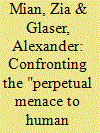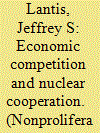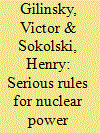| Srl | Item |
| 1 |
ID:
127633


|
|
|
|
|
| Publication |
2014.
|
| Summary/Abstract |
Nuclear weapon states historically have attached great secrecy to their nuclear weapon and fissile material production programs and stockpiles, despite warnings that this would fuel fears, handicap informed debate and decision making, and drive arms races. As evidenced by the "Action Plan on Nuclear Disarmament" agreed upon at the 2010 Treaty on the Non-Proliferation of Nuclear Weapons (NPT) Review Conference, however, the international community now sees greater transparency about nuclear weapon and fissile material stocks as necessary for enabling and monitoring progress toward nuclear disarmament. To support this effort, the International Panel on Fissile Materials has proposed a step-by-step program for weapon states to declare their inventories, production histories, and disposition of nuclear warheads and fissile materials, and to set up joint projects to develop methods for verifying these declarations. This openness initiative is described here, and could be adopted at the 2015 NPT Review Conference, laying a basis for negotiating verifiable deep reductions in nuclear arsenals and their eventual elimination.
|
|
|
|
|
|
|
|
|
|
|
|
|
|
|
|
| 2 |
ID:
127622


|
|
|
|
|
| Publication |
2014.
|
| Summary/Abstract |
The number of bilateral nuclear cooperation agreements surged during the "nuclear renaissance" of the past decade. This proliferation is only partially explained by the prevailing approaches that focus on strategic imperatives. To supplement these explanations, this study draws on neoliberal models of economic competition to posit that bilateral agreement negotiations also exhibit conditions of "uncoordinated interdependence" and maneuvering to gain market share. Case evidence suggests the contours of supplier state bids for civilian assistance are determined at least as much by considerations about economic competition as they are by positive strategic goals. In addition, this study identifies several cases of cooperation where there appears to be little or no strategic motive for export agreements. The study concludes that patterns of economic competition and the influence of peers in defined competitive spaces alter material payoffs and impact policies. It also identifies a surprising role for principled restraint in dampening strategic and economic competition in some dyads.
|
|
|
|
|
|
|
|
|
|
|
|
|
|
|
|
| 3 |
ID:
127626


|
|
|
|
|
| Publication |
2014.
|
| Summary/Abstract |
The biological and chemical weapon nonproliferation and disarmament regimes are often put forward as models of what the nuclear nonproliferation regime could (or should) be. But are these regimes effective? If so, is one stronger and/or more effective than the other? What is it that makes them relatively stronger than the nuclear nonproliferation regime? In this article, we return to and expand upon a framework for assessing regime health and effectiveness. We utilize this framework to engage in a comparative analysis of the chemical weapon (CW) and biological weapon (BW) nonproliferation regimes, respectively. Our analysis reveals that these two regimes are comparatively healthier than their nuclear counterpart. While some of their behavioral features might be troubling-such as the disputes over stockpile destruction of CW-these tend to be mitigated by the presence of a strong norm against possession and proliferation of both CW and BW. This norm is adequately embedded into the existing institutional features of the regimes in ways that do not exist in the nuclear nonproliferation regime.
|
|
|
|
|
|
|
|
|
|
|
|
|
|
|
|
| 4 |
ID:
127638


|
|
|
|
|
| Publication |
2014.
|
| Summary/Abstract |
The authors propose five principles for addressing the major deficiencies of the current treaty-based approach to nonproliferation. These involve: effectively closing the door to withdrawals from the Treaty on the Non-Proliferation of Nuclear Weapons (NPT); defining which nuclear technologies fall within the NPT's "inalienable right" provision, so as to maintain a reasonable safety margin against possible military application; expansion of International Atomic Energy Agency inspections to include greater readiness to use its "special" inspection authority; creation of an NPT enforcement regime, to include a secretariat; and universalizing the NPT so as to apply to all states, while creating a path for current non-parties to come into compliance. There is no illusion here about the prospects for the adoption of this approach. At a minimum, the world needs to be frank about the gap between nuclear programs and current nonproliferation protection. Encouragement of greater use of nuclear power should be predicated on closing that gap.
|
|
|
|
|
|
|
|
|
|
|
|
|
|
|
|